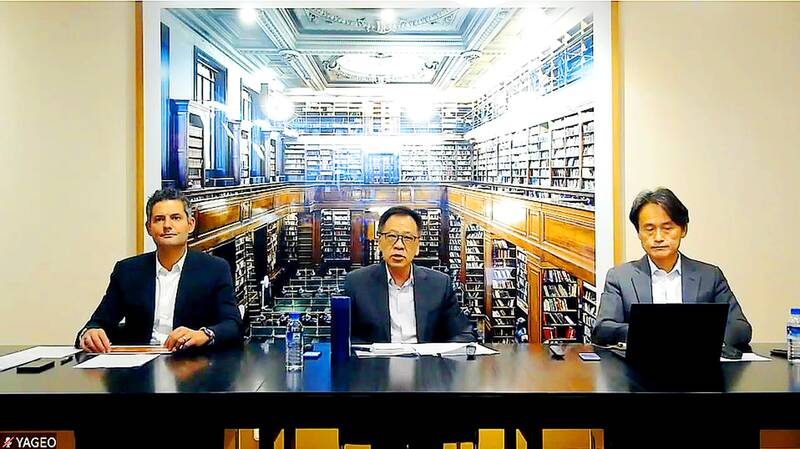Yageo Corp (國巨), the world’s third-largest supplier of multilayer ceramic capacitors (MLCCs), yesterday projected that its revenue would be little changed this quarter and the next on a sequential basis, as signs of an exuberant recovery are lacking.
With a lukewarm increase in end-market demand, the passive components maker expects channel inventory adjustments to continue for another one to two quarters.
Yageo’s conservative outlook came as the firm reported its weakest profit in nine quarters last quarter.

Photo: Chang Hui-wen, Taipei Times
Net profit for the April-to-June quarter tumbled 37 percent to NT$3.73 billion (US$119.15 million), from NT$5.93 billion in the same period last year. That represented a decline of 9.7 percent from NT$4.13 billion a quarter earlier.
“The current market [condition] seems to have reached the bottom. However, we haven’t seen signs of very strong demand yet,” Yageo CEO David Wang (王淡如) told an online investors’ conference.
Revenue would be flat this quarter compared with NT$26.76 billion a quarter earlier, Wang said, adding that gross margin would be flat, or improve slightly from 33.2 percent last quarter.
Overall, Yageo expects to generate more revenue in the second half of the year than the first half, Wang said.
To cope with tepid market demand while reducing its inventory further, Yageo would extend its one-year factory utilization control policy into this quarter, the company said.
The day-of inventory gauge stood at 129 days last quarter, higher than the firm’s target of fewer than 120 days, it said.
The utilization of manufacturing equipment for premier passive components would remain at about 70 percent this quarter — the same as last quarter, Yageo said, adding that the usage of manufacturing equipment for commodity-type products would be 40 to 50 percent.
Yageo said it has recently seen signs of a recovery in its MLCC business, as customers have started restocking inventory lately.
The company’s MLCC business was its second-largest revenue contributor last quarter, accounting for 22 percent of its total sales.
Demand from the car, electric vehicle and industrial segments would remain robust in the second half of the year, extending the growth recorded in the first half, Yageo executive vice president of global sales and marketing Claudio Lollini said.
However, the demand profile for desktop computers, notebook computers and smartphones remains lackluster, Lollini said.
Yageo did not see any major decline in its average selling prices, aside from seasonal adjustments, he added.
Lollini said it would be difficult to quantify how many business opportunities the adoption of artificial intelligence chips would bring to the company, but it is certain that each AI server is equipped with many more components than a traditional server.
Yageo’s MLCCs and chip resistors have exposure to the AI market, he added.

Taiwan’s long-term economic competitiveness will hinge not only on national champions like Taiwan Semiconductor Manufacturing Co. (TSMC, 台積電) but also on the widespread adoption of artificial intelligence (AI) and other emerging technologies, a US-based scholar has said. At a lecture in Taipei on Tuesday, Jeffrey Ding, assistant professor of political science at the George Washington University and author of "Technology and the Rise of Great Powers," argued that historical experience shows that general-purpose technologies (GPTs) — such as electricity, computers and now AI — shape long-term economic advantages through their diffusion across the broader economy. "What really matters is not who pioneers

In a high-security Shenzhen laboratory, Chinese scientists have built what Washington has spent years trying to prevent: a prototype of a machine capable of producing the cutting-edge semiconductor chips that power artificial intelligence (AI), smartphones and weapons central to Western military dominance, Reuters has learned. Completed early this year and undergoing testing, the prototype fills nearly an entire factory floor. It was built by a team of former engineers from Dutch semiconductor giant ASML who reverse-engineered the company’s extreme ultraviolet lithography (EUV) machines, according to two people with knowledge of the project. EUV machines sit at the heart of a technological Cold

TAIWAN VALUE CHAIN: Foxtron is to fully own Luxgen following the transaction and it plans to launch a new electric model, the Foxtron Bria, in Taiwan next year Yulon Motor Co (裕隆汽車) yesterday said that its board of directors approved the disposal of its electric vehicle (EV) unit, Luxgen Motor Co (納智捷汽車), to Foxtron Vehicle Technologies Co (鴻華先進) for NT$787.6 million (US$24.98 million). Foxtron, a half-half joint venture between Yulon affiliate Hua-Chuang Automobile Information Technical Center Co (華創車電) and Hon Hai Precision Industry Co (鴻海精密), expects to wrap up the deal in the first quarter of next year. Foxtron would fully own Luxgen following the transaction, including five car distributing companies, outlets and all employees. The deal is subject to the approval of the Fair Trade Commission, Foxtron said. “Foxtron will be

INFLATION CONSIDERATION: The BOJ governor said that it would ‘keep making appropriate decisions’ and would adjust depending on the economy and prices The Bank of Japan (BOJ) yesterday raised its benchmark interest rate to the highest in 30 years and said more increases are in the pipeline if conditions allow, in a sign of growing conviction that it can attain the stable inflation target it has pursued for more than a decade. Bank of Japan Governor Kazuo Ueda’s policy board increased the rate by 0.2 percentage points to 0.75 percent, in a unanimous decision, the bank said in a statement. The central bank cited the rising likelihood of its economic outlook being realized. The rate change was expected by all 50 economists surveyed by Bloomberg. The